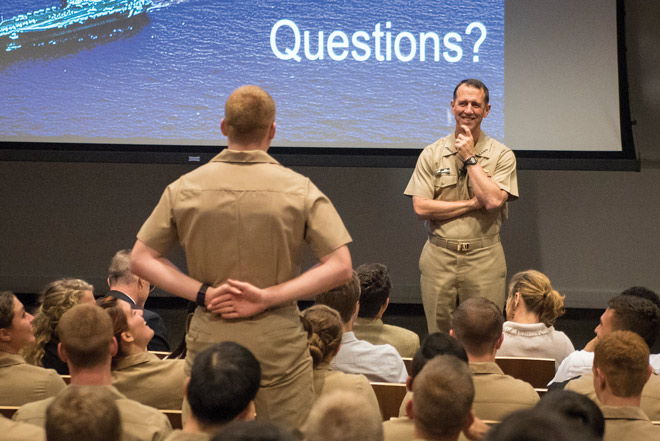
Historically, each Chief of Naval Operations (CNO) has arrived in office with the apparent conviction that he had a fundamental vision of something critical yet insufficiently appreciated by others. The CNO would make that “something” a centerpiece of his administration. He also understood that his time as CNO was short, generally four years. As a result, if he wished to weave his vision into the fabric of the Navy, he would have to act decisively and persistently. He knew, too, that he would have to suppress competing visions, both old and new, and from high and low.
Surprisingly, these CNO visions often were unrelated to the actual application of naval force.
• Admiral Frank B. Kelso focused on Deming’s Total Quality Leadership (TQL).
• Admiral Vern Clark, who had an MBA, determined the Navy should be run more like civilian industry.
• Admiral Mike Mullen made it his goal to drag the Navy into the 21st century, socially speaking.
• Admiral John Richardson wishes to build the Columbia-class ballistic-missile submarine and to morph the Navy’s “timeless” core values of honor, courage, and commitment into integrity, accountability, initiative, and toughness.
Almost every CNO develops a strategic vision in some way that supports the Navy’s mission: “To maintain, train, and equip combat-ready Naval forces capable of winning wars, deterring aggression, and maintaining freedom of the seas.” Exactly how each CNO decides to carry out this mission seems to change, which explains why the Navy’s strategic vision transforms every four years. Each CNO also presents a methodology intended to support his vision of the mission.
Admiral Richardson’s strategy, for example, calls for high-velocity learning; support of the “Sailor 2025” initiative; close cooperation with other services, industry, allies, and partners; and strengthening naval power at and from sea. It seems odd that this “strategy” appears to be more administrative than strategic, although it is not alone in this regard. An actual “Mahanian” strategy seems to have been all but lost since perhaps 1994’s “Forward . . . From the Sea.” As a result, it is difficult to find a chief, ensign, or department head who can sensibly explain today’s Navy’s strategy.
In 2014, Admiral Jon Greenert, speaking to the “Current Strategy Forum” at the Naval War College, allowed as how he had not developed his own strategy but explained: “The Current Strategy Forum idea came up and I said that’s it, I’m hijacking the damn thing if I can . . . we’re going to talk about strategy. I want as many people, different kinds of folks . . . and then we’ve got to talk about strategy.” But the Navy never implemented a process to make this happen.
Is it time for the Navy to establish a strategy board that is both powerful and independent of individual fiat or fashion. This board will ensure that a strategy, operational and tactical plans, and visions exist, align, and are mutually supportive, horizontally, vertically, and across time.
This organization should be populated by Navy captains from different communities. They should be voluntarily assigned for up to eight years, and they should be without flag aspiration, lest personal ambition and community loyalty intrude in their work of overseeing one true strategy, top to bottom.
These captains should be led by a four-star flag officer who, like the Chief of Naval Reactors, should spend the rest of his or her flag career in this one position. Only then will he or she be free of parochialism and rank ambition.
Think about TQL and the so-called “5 vector model.” Both those efforts had billions of dollars behind them and what were the results?
The Navy needs a consistent strategy to effectively husband its resources and focus its energy.
Captain Eyer served in seven cruisers, commanding three Aegis cruisers: the USS Thomas S. Gates (CG-51), Shiloh (CG-67), and Chancellorsville (CG-62).
Photo credit: U.S. Navy (Nathan Laird)


